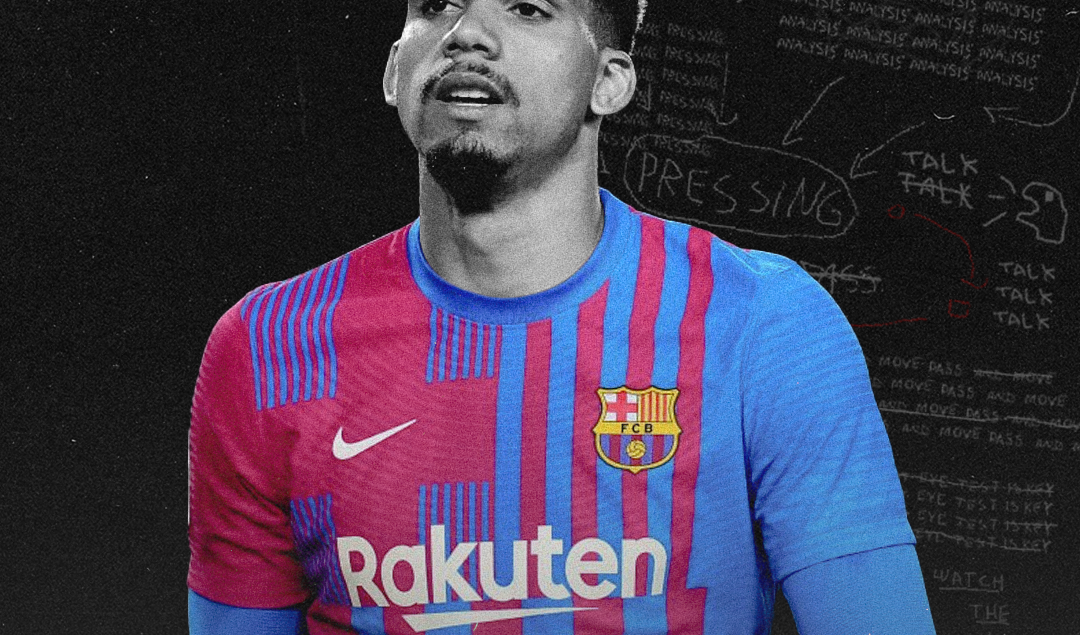Tactical Analysis: Barcelona 3-1 Real Madrid
Saudi Arabia recently played host to the Supercopa de España as LaLiga Santander holders Real Madrid faced long-time rivals FC Barcelona in the 251st El Clásico between the two sides. The Spanish giants have largely been neck-and-neck throughout this season’s league title race, therefore this clash presented both sides with an opportunity to build momentum before resuming league games back on Spanish soil.
Prior to kick-off, the general feeling was that the game could go either way with both sides possessing flaws that could be exploited by the opposition. However, it didn’t take long for the Culers to take control of the game and assert their authority over proceedings. This piece will attempt to analyse how Xavi set-up his Barcelona side both in and out of possession, as well as Carlo Ancelotti’s attempts to counteract this and why he was unable to keep Barça’s creators at bay.
Basic statistics may suggest that this was a somewhat close encounter as Real Madrid and Barcelona ended the contest with 46% and 54% possession respectively, with Madrid recording 12 shots to Barcelona’s 11, but this neglects a lot of context. According to @markrstats on Twitter, Barcelona accumulated an xG (expected goals) of 2.23 to Real Madrid’s 0.79 over the course of the game, reflecting the dominant performance from Xavi’s side, especially in advanced areas.
Real Madrid looked threatening at times, but often lacked the final ball to make use of their territory. Much of the threat generated by Los Blancos came in transition as they were prepared to allow Barça to control possession in long phases before using pace and directness to exploit open spaces on the break. However, as the progression of the game showed, this tactic wasn’t particularly successful as Barcelona controlled proceedings.
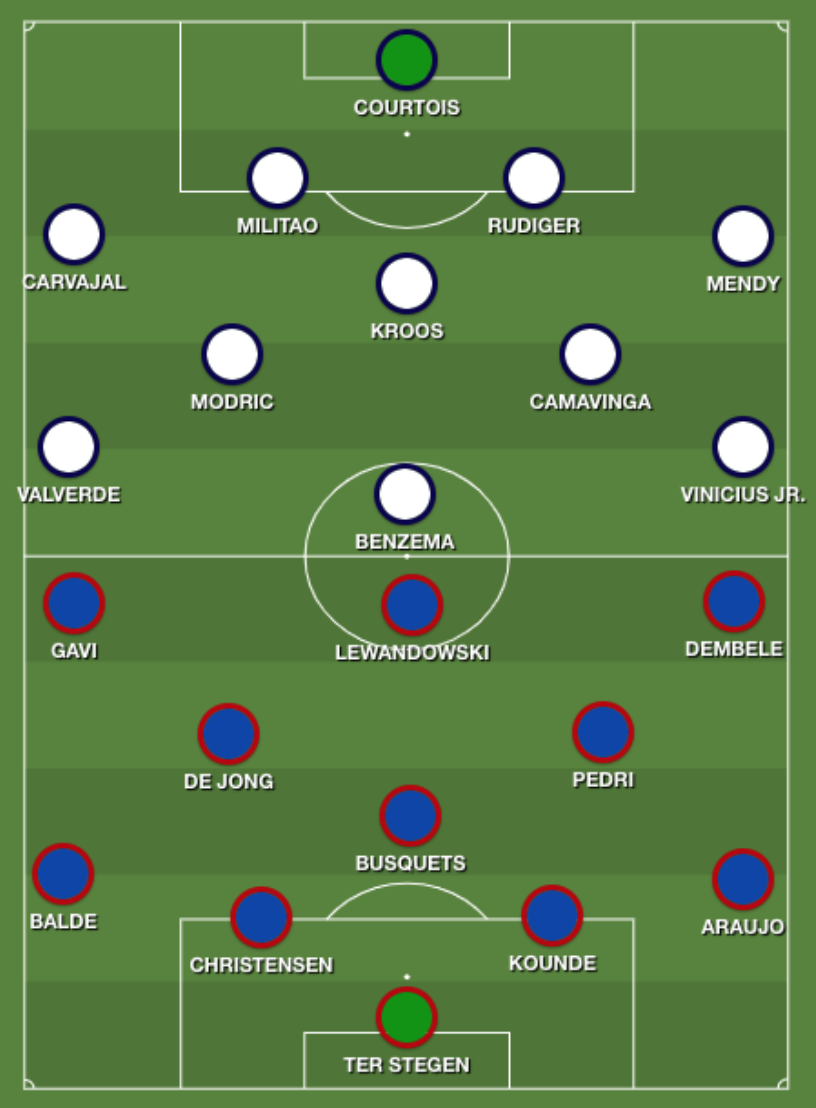
Real Madrid and Barcelona’s starting line-ups
Both sides set up in a 4-3-3 formation, but the actual structures of these systems differed drastically. Xavi appeared to be far more cerebral in his approach, deploying many aspects of positional play to exploit specific weaknesses in Real Madrid’s setup. Contrastingly, Ancelotti’s men were far more fluid, relying more on individual quality of the players and were allowed more freedom to occupy various positions, depending on where the players felt they might create a superiority.
Barcelona’s 4-3-3 became a 3-2-5 in possession. This is a shape that has become increasingly popular in modern football due to its offensive and defensive balance, as well as its ability to stagger wide players and cause indecision in the opposition.

In this shape, we see the wide players staggered positionally. Alejandro Balde holds the width high on the left whilst Ronald Araújo stays next to the centre-backs to form a back 3. On the wings, due to Balde holding the width, Gavi comes inside and plays as a playmaker in the left half-space, whereas Ousmane Dembélé stays high and wide, holding the width on the right flank, pinning back Ferland Mendy and creating more space for Pedri in the right half-space.
Sergio Busquets and Frenkie de Jong operate in a double pivot to control central areas, although De Jong and Pedri would occasionally switch positions, especially in the second half. This 3-2-5 could also transition to a 3-box-3 if Gavi and Pedri played further behind Lewandowski to create a numerical overload against Real Madrid’s midfield trio.
These central overloads would create extra space for Balde and Dembélé on the flanks. Balde particularly overwhelmed Dani Carvajal with his pace and athleticism, often forcing Valverde to drop deeper to support his full-back, subsequently taking away another one of Madrid’s counter-attacking outlets. Occasionally, Frenkie de Jong would move into a more advanced position and Barça would set up in a 3-1-6 shape, akin to the shape that has been implemented by Erik ten Hag at Manchester United.

This shape gave Barcelona’s deeper creators more passing options between the lines and pinned Real Madrid further back, closer to the defensive line. This was indicative of Xavi’s willingness to commit more men in and around the box and apply pressure to Madrid’s goal. Frenkie de Jong’s positional fluidity was key to disrupting Real Madrid’s shape and creating more passing lanes for himself and his teammates.
This level of tactical nous appeared to be missing from the approach employed by Los Merengues. Ancelotti deployed his men in a more traditional 4-3-3 shape that we’ve grown accustomed to seeing from the UEFA Champions League holders. Toni Kroos usually played as the holding midfielder but would occasionally move into left half-space, with Eduardo Camavinga moving into the holding midfield position. We would also see Kroos drop between the centre-backs on occasion in order to create a numerical superiority in the first phase against Barcelona’s press.
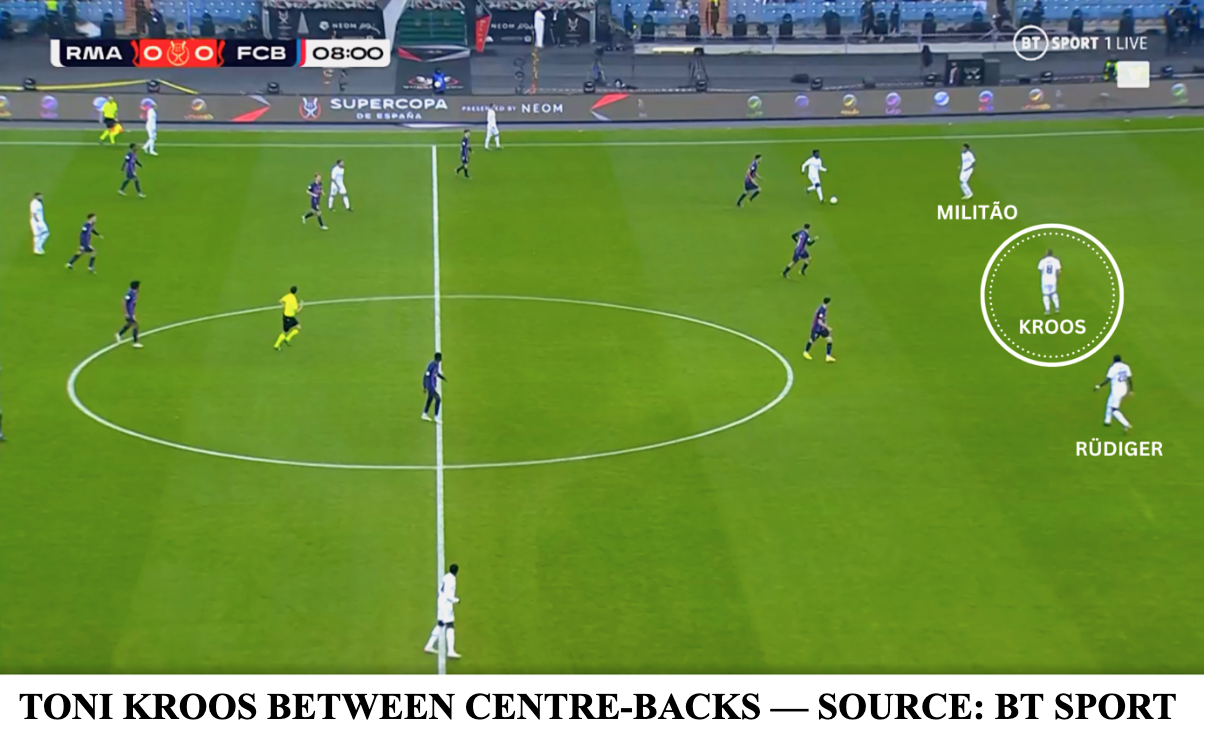
Whilst this approach did help against Barcelona’s high press in the first phase, it also often resulted in a lack of central passing options between the lines, forcing Real Madrid to play the ball wide without really disrupting their opponents’ shape. Higher up the pitch, the front 3 were given freedom to roam from their positions and find space in which to receive the ball whilst also creating overloads out wide and freeing up space on the opposite flank.

Whilst this did create overloads in theory as it forced Barcelona to defend in a narrow shape, Los Blancos were unable to exploit this as the opposite-sided full-back often wasn’t aggressive enough or simply didn’t have the requisite ability to exploit the space created on his flank.
Vinícius Jr. and Federico Valverde would also often move into narrow positions next to Karim Benzema in order to create central overloads and open up space for the full-backs — a move we often saw utilised by Carlo Ancelotti during his side’s Champions League-winning campaign last season.

Once again, this approach was effective in theory, but the lack of aggressiveness and explosiveness possessed by Madrid’s full-backs meant that they couldn’t make the most out of these advantages. The high work-rate of Ousmane Dembélé and Gavi also played a major role in Barcelona maintaining a strong horizontal shape as the two wide players often dropped deep to support their full-backs defensively, preventing easy 1 vs. 1 situations.
These movements and positional rotations were attempted often by Real Madrid, but they were rarely effective and tended to feel more random than orchestrated. In general, it was very difficult for Madrid to create anything concrete in possession largely due to Barcelona’s aggressive press off the ball.
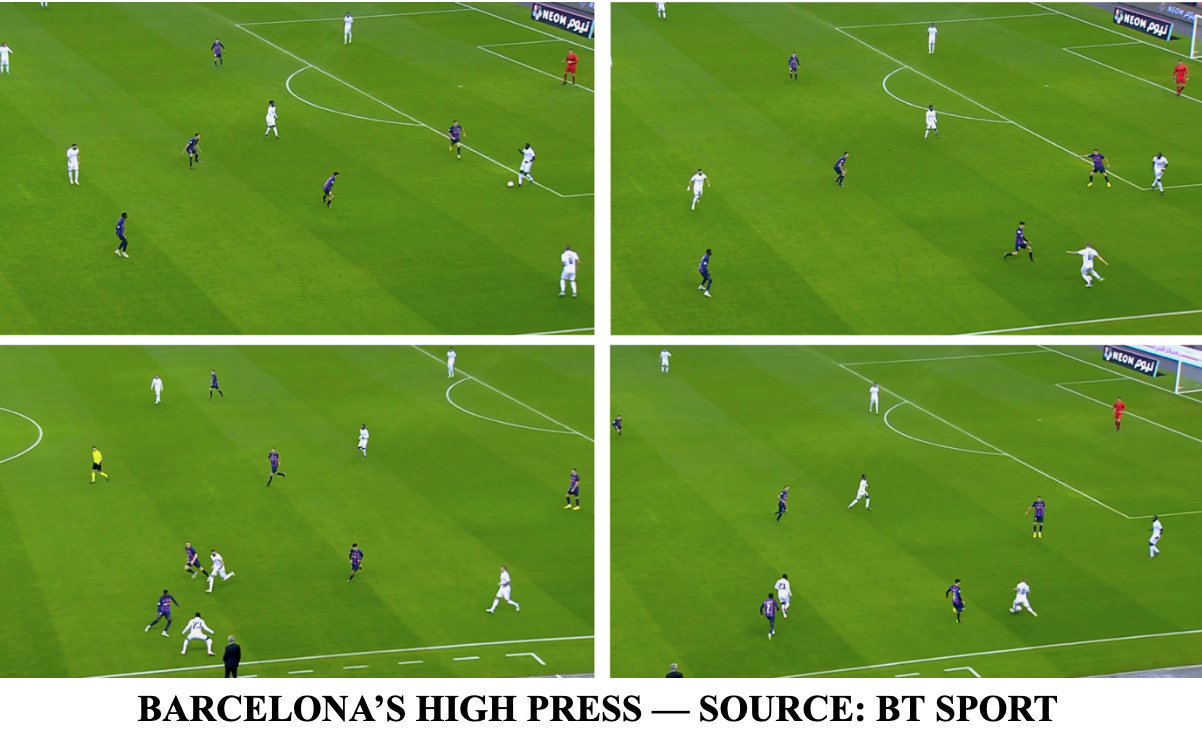
The Culers employed a high, man-oriented press out of possession as they attempted to keep the ball in Madrid’s half and establish territorial control. When the initial press was beaten, Barcelona would settle into a mid-block but constantly look for triggers to reignite the press. In some instances, the 4-3-3 shape became a 4-4-2 — or 4-4-1-1 — in order to keep a man close to Real Madrid’s holding midfielder, often Toni Kroos. The approach was calculated and intentional and, as such, it was very efficient, effectively leading to Barça’s opening goal.
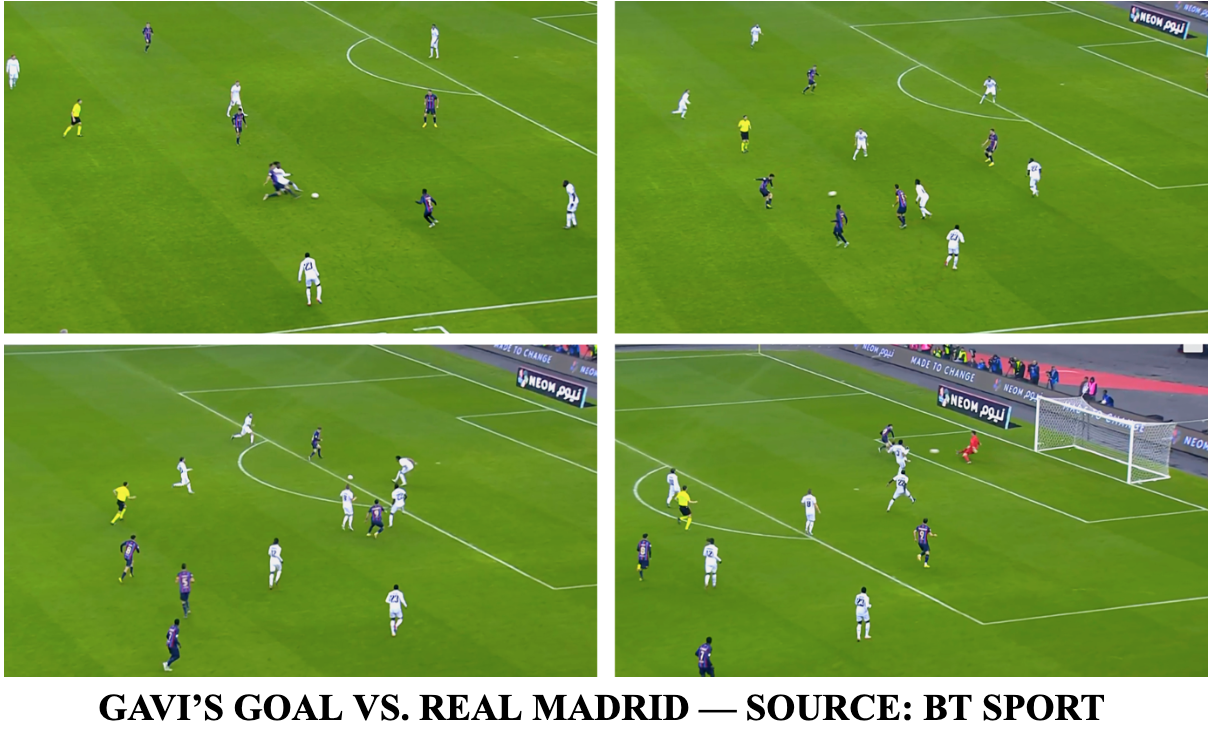
Sergio Busquets dispossesses Eduardo Camavinga in a dangerous zone and this allows Barcelona’s forwards to attack Real Madrid’s defence whilst it is still disorganised, resulting in Lewandowski finding Gavi who finishes past Courtois with a composed left-footed finish.
Barça’s structured press results in a high-quality chance and, subsequently, a goal, proving Xavi’s meticulous planning paid off. From this point on, Barcelona were able to control the tempo of the game and pick their opportunities to attack more aggressively when Real Madrid overcommitted with or without the ball. Barcelona’s second goal is a beautifully executed move that arises from the detailed shape and patterns deployed by Xavi.

Frenkie De Jong moves ahead of Busquets into a more advanced position, similar to that of the 3-1-6 shape. In this zone, he draws multiple Real Madrid defenders out of position and slides a pass in behind for Gavi who can run into a large open space created by Madrid’s poor positioning. At this point, it is essentially a 2 vs. 1 situation in Barcelona’s favour and Gavi calmly picks out Robert Lewandowski who simply cannot miss from that distance.
Real Madrid were carved open by incisive passing and movement from their rivals and the mountain they had to climb after this goal was virtually insurmountable. The men in white simply couldn’t match their opponents’ energy and intensity, and this was reflected by their own pressing (or lack thereof). Real Madrid generally didn’t press high, instead waiting for Barcelona to progress the ball before applying pressure from a mid-block or, less favourably, a low-block.
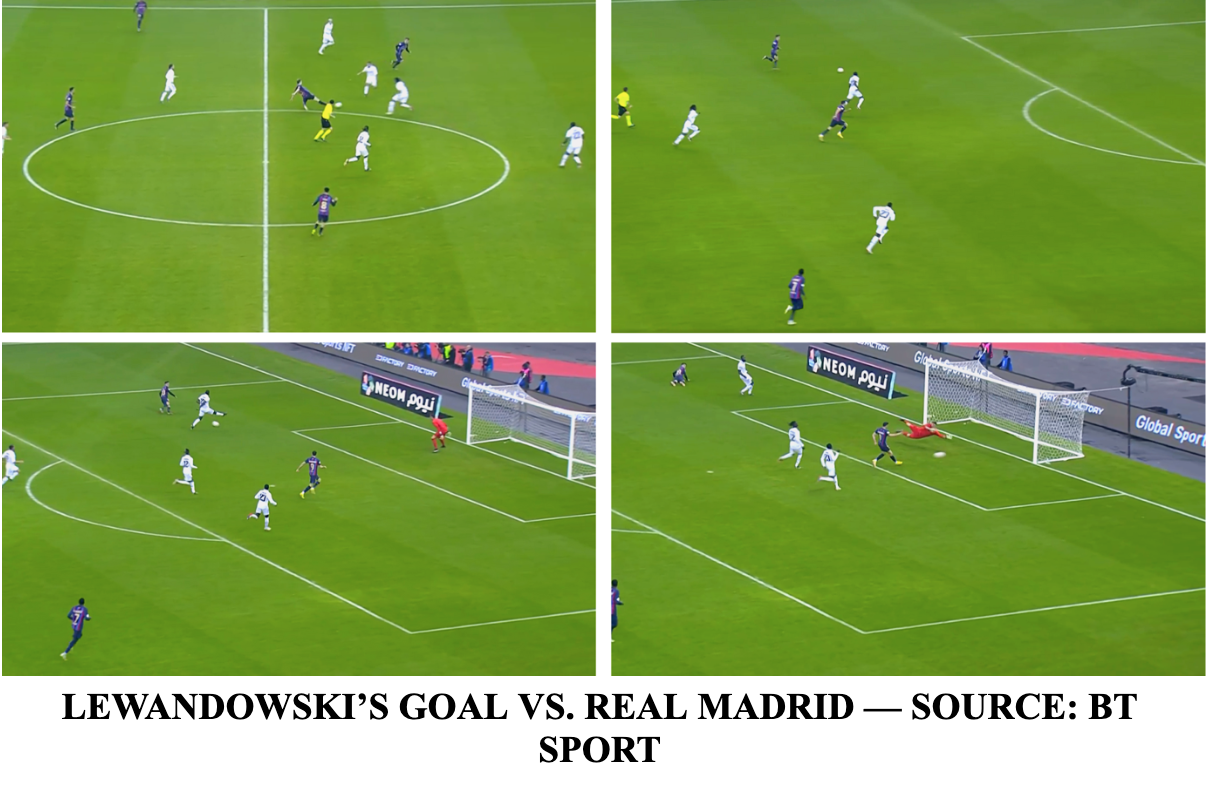

Whilst this more cautious approach has worked for Carlo Ancelotti in the past, this wasn’t the game for conservatism. Barça took full advantage of this passive approach and circulated the ball in the areas they most desired. They combined possession with territory and created multiple openings as a result. Madrid’s lack of press on Barça’s deeper creators meant progressive passes came far easier for them and were often met with little resistance.
Real Madrid did look more threatening in the second half, but this may have been a symptom of the comfortable position Xavi’s men were in whereby they could play a more cautious and reserved game without the need to pursue a goal. As Madrid attacked with more numbers, this opened up counter-attacking opportunities for Barcelona, particularly via Ousmane Dembélé due to his devastating pace. However, the third goal actually came via Gavi’s flank after a poor turnover in the middle of the park.
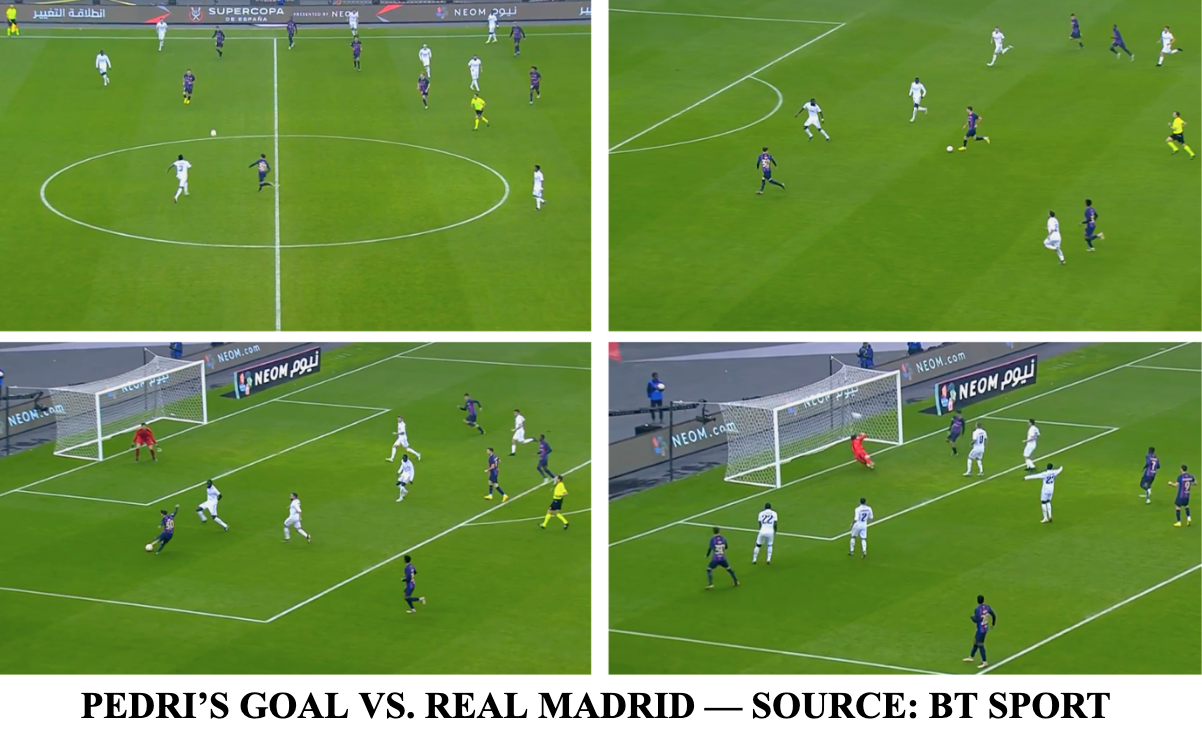
Gavi pounces on a reckless pass from Dani Ceballos into the midfield area. Similarly to the first goal, Real Madrid are completely disorganised in this situation, allowing Gavi to combine with Robert Lewandowski, who returns the ball to the 18-year-old. Gavi is then able to slide the ball across the box to his fellow Spaniard, Pedri, who easily slots past a helpless Thibaut Courtois.
The third goal essentially killed the game off and allowed Barcelona to focus on defensive solidity and avoiding mistakes as opposed to attempting to increase the lead. Many of Real Madrid’s shots were half-chances that posed little threat to Marc-André ter Stegen until Karim Benzema managed to squeeze in a consolation goal in stoppage time. His celebration was notably muted as everyone had acknowledged that the game was over by this stage and that his goal was purely cosmetic.
In the end, Barcelona walked away with a comfortable 3-1 victory over their arch-rivals and this result is indicative of the positive work being done by Xavi at the club despite their disappointing early Champions League exit. They look favourites to win LaLiga Santander this season as they hold a three-point lead over Real Madrid at the time of writing. The Supercopa de España may not be seen as the most prestigious trophy, but wins such as these often act as springboards towards crucial runs in the quest for other major honours, especially league titles.
By: Lebohang Mwamuka / @lebzygold
Featured Image: @GabFoligno / Alex Caparros / Getty Images
